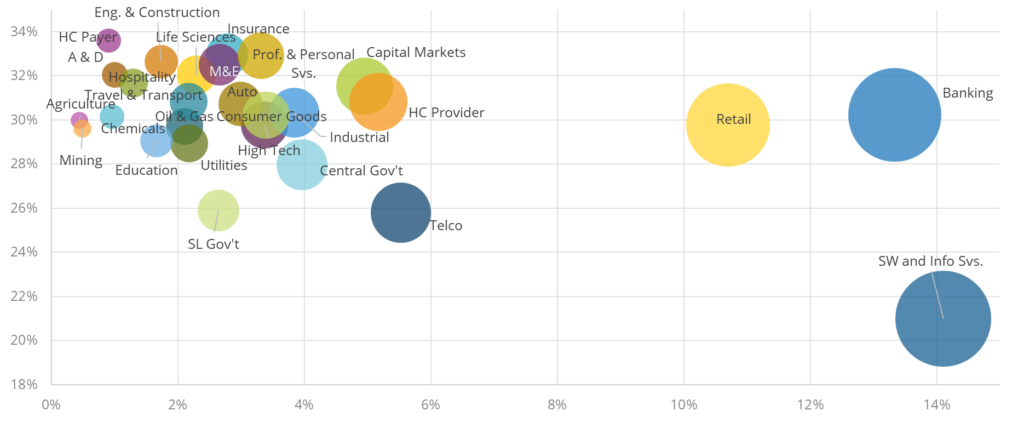In the rapidly evolving landscape of technology, Artificial Intelligence has emerged as a beacon of innovation, with companies looking to increase operational efficiency, cost savings and improve employee productivity through AI initiatives.
AI and Generative AI Spending Across the Globe
IDC has recently unveiled the latest release of its Worldwide AI and Generative AI Spending Guide, 2024 V2. Presently, the global Artificial Intelligence market stands at nearly $235 billion, with projections indicating a rise to over $631 billion by 2028.
The three leading industries in terms of Artificial Intelligence spending are Software and Information Services, Banking, and Retail. Combined, these sectors are projected to allocate approximately $89.6 billion towards AI in 2024, representing 38% of the global AI market. With an impressive five-year Compound Annual Growth Rate (CAGR) of 27%, their collective investment is anticipated to surge to nearly $222 billion by 2028. Notably, Generative AI accounts for more than 19% of the total investment across these three industries, highlighting its growing significance in the AI landscape.
Worldwide AI and Generative AI Spending by Industry

Industries Key Highlights in Artificial Intelligence
The Software and Information Services industry is known for its dynamic nature and rapid growth, is now at the forefront of integrating Artificial Intelligence to revolutionize how services are delivered and consumed. With a spending of $33 billion in 2024, companies are using AI to make the software development lifecycle more efficient and error-resistant through AI lifecycle software and predictive models. Enhancing information services by personalizing content delivery based on user data, thus improving user engagement. Artificial Intelligence is also driving innovation by creating new products and tools for data analysis and market trend prediction, helping businesses stay competitive. Additionally, AI is augmenting and automating operational processes, increasing efficiency, and reducing costs by allowing functions such as human resources to focus on strategic tasks. This comprehensive integration of AI is not only streamlining operations but also fostering the development of high-quality, adaptive software and services.
The Banking industry, a market with approximately $31.3 billion in investments in AI in 2024, is using the technology to enable banks to offer personalized customer experiences through machine learning and data analytics, allowing banks to tailor services to individual preferences. AI-powered chatbots and virtual assistants provide round-the-clock assistance for both basic and complex tasks, improving customer service and allowing human representatives to focus on intricate issues. Robotic Process Automation (RPA) streamlines back-office operations, reducing costs and errors. AI algorithms enhance fraud detection and risk management by analyzing transaction patterns and customer behavior for real-time action, thus protecting assets and building trust. In investment banking, AI-driven algorithmic trading analyzes market data for quick, strategic trading decisions, while AI also improves risk assessment models by predicting market shifts, aiding in informed investment decisions and risk management.
Spending in AI for the retail industry is reaching around $25 billion in 2024. Artificial Intelligence is revolutionizing the retail industry by creating personalized shopping experiences through machine learning and data analytics, enabling retailers to understand and cater to individual customer preferences. This leads to enhanced customer engagement and loyalty with customized product recommendations and targeted marketing. AI also addresses inventory management challenges by predicting demand patterns and optimizing stock levels, reducing overstock and stockouts. AI-powered chatbots and virtual assistants improve customer service by handling inquiries efficiently, enhancing customer satisfaction. Additionally, in physical stores, Artificial Intelligence enhances the shopping experience with technologies like smart mirrors for interactive advertisements, promotion and product information and AI-driven systems for improved store security and layout optimization.
Regional Outlook in Artificial Intelligence
In both the Americas and EMEA regions, the banking industry emerges as the top spender in Artificial Intelligence, with market sizes estimated at approximately $19 billion and $8 billion for 2024, respectively. These markets are experiencing robust growth, with five-year Compound Annual Growth Rates (CAGRs) of 30% and 32%. Conversely, in the Asia-Pacific and Japan (APJ) region, the Software and Information Services Industry takes the lead in AI investments, boasting a nearly $11 billion market size, characterized by early and rapid adoption of certain AI technologies. A common trend across all three regions is the relatively low AI spending in the agriculture and fishing industry, marking it as the industry with the least investment in AI technologies.
Conclusion
The integration of Artificial Intelligence across various industries is not just a trend but a transformative shift that is reshaping the landscape of business, technology, and customer interaction. From retail to banking, software and information services to healthcare, AI is enhancing efficiency, personalizing experiences, and opening new avenues for innovation and growth. It’s clear that AI’s potential to drive operational excellence, understand and predict consumer behavior, and innovate product development is unparalleled. As industries continue to harness the power of AI, IDC continues to follow this journey closely and offers the latest insights in about AI and Generative AI spending across the globe.
Learn more about IDC’s AI and GenAI Spending Guide by downloading this product overview.
Find out what matters most to your customers with IDC’s AI Use Case Discovery Tool.
Contributing Author: Mariana Fang – Research Analyst, Data & Analytics




